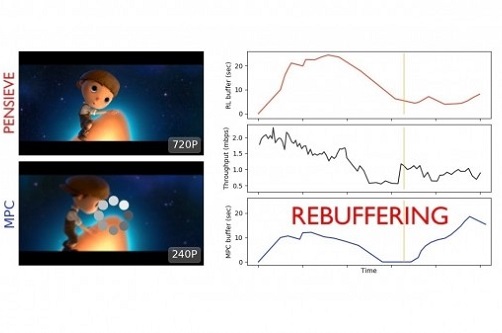Technology Trends A team of researchers at the MIT Computer Science and Artificial Intelligence Laboratory has developed an artificial intelligence called Pensieve that can make slow or fuzzy network video a thing of the past.
Streaming video content has been developing leaps and bounds in recent years, but unfortunately its bandwidth requirements have also seen a leap forward. To overcome this challenge, video platforms like YouTube or Netflix use an algorithm that divides the video into more manageable blocks. If their system detects that your Internet speed is slowing down, the next video clip will be played at a lower resolution, and efforts are made to catch up with the progress of the playback in this way.
The idea behind the system is to ensure smooth video playback, but sometimes even if quality drops, the video will pause for a few seconds as it tries to buffer the next block. This is because the algorithm does not always predict exactly what resolution the next block should use.
This is where Pensieve comes in. MIT researchers use a reward and punishment system to develop it and train it to identify effective buffering techniques. For example, Pensieve can be rewarded for successfully playing a complete video without having to re-cache. If the video quality falls below a certain threshold, it may be punished.
Dr. Hongzi Mao, Ph.D., who is the main author of the paper describing the process and function of Pensieve, said that “by looking at the actual performance of the past, it learns how different strategies affect performance and it can improve its decision strategy in a harder way. ."
According to the research team's paper, Pensieve can reduce video traffic by 10% to 30% over other systems, and users rate their "Quality of Experience" as a 10% to 20% increase.
Mao said that Pensieve has enough flexibility to adapt to different requirements. For example, they can be trained to ensure continuous video playback at the expense of resolution, or they can be trained in the opposite direction, giving priority to quality over smoothness.
The next project of the research team will be to test the effectiveness of Pensieve in streaming virtual reality content. It requires a much higher bandwidth and has a much lower tolerance for low quality.
MIT professor Mohammad Alizadeh (Mohammad Alizadeh) is a co-author of this paper at Pensieve. He said: "The 4K quality VR you need can easily reach hundreds of megabits per second, today's The network can't support it at all." He said, "We are very happy to see everything that a system like Pensieve can do for VR and other technologies. This is just the first step."
Reflective warning`s reflection part of the garments is the use of
lattice micro-rhombus type refraction and high refractive index of glass beads
back to the principle of reflection, through the post-processing of advanced
processing technology made. It can reflect the distant light back to the light.
Both in the day or night have a good retroreflective optical performance.
Especially at night, it can play the same high visibility as the day. The use
of this high-energy reflective material made of safety clothing, whether the
wearer is in the distance, or in the light or scattered light interference, it
can be relatively easy to be found by the night driver.
Reflective Garments
Reflective Garments,Knitting Reflective Garments,Mesh Reflective Garments,Kids Reflective Garments
Daoming Optics & Chemical Co., Ltd , https://www.reflectives.nl
